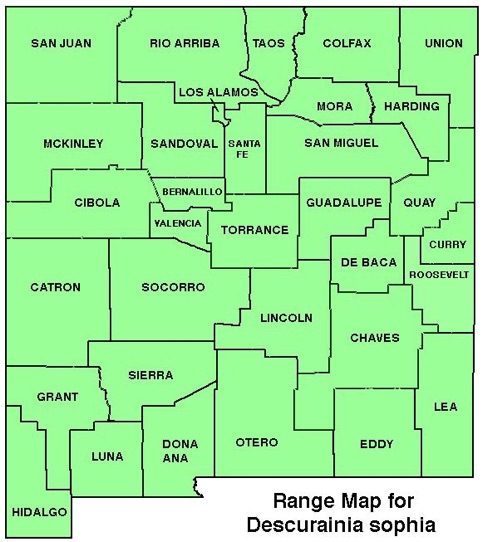WILDFLOWERS OF NEW MEXICO

Growing from a base of fern-like leaves, this is one of the first wildflowers to appear in spring. Heads of tiny, yellow flowers crown the erect, 12–32-inch tall stems. The ripening thin seed pods line the stem as it continues to grow and flower. Note the narrow pods reach 1-inch long and the leaves have narrow segments divided 2–3 times. Fall germinating seeds overwinter as rosettes.
FLOWERS: February–July. Yellow, 4 tiny petals, 1/16–1/8 inch long (2–3 mm), oval shaped; flowers clustered on upright head. Thin, linear seed pods (siliques) are hairless, point outward and upward, slightly curved, 1/2–1 inch long (15–27 mm); stem of pod (pedicel) 3/8–5/8 inch long (8–15 mm).
LEAVES: Alternate, pinnately to bipinnately compound, smaller towards top. Blade 1–4 inches long (2–10 cm), divided 2–3 times with slender, linear, pointed leaflets.
HABITAT: Sandy, gravelly soils, roadsides, disturbed areas; deserts, sagebrush, pinyon-juniper woodlands.
ELEVATION: 4,300–8,300 feet.
RANGE: Introduced, naturalized throughout North America.
SIMILAR SPECIES: Three widespread native species of tansy mustards grow in NM: D. obtusa in the west half of NM has hairy pods when young and leaflets usually with rounded tips; D. incana in the western 2/3rds of NM has lobed leaflets and pods indented to the midrib around the seeds, but not always distinguishable from D. pinnata; Western Tansy Mustard, D. pinnata throughout NM has, hairy leaflets with rounded lobes and club-shaped pods. Similar mustards in the Sisymbrium genus have pinnately lobed leaves, not fern-like leaves.
NM COUNTIES: Statewide.

FLIXWEED, TANSY MUSTARD
DESCURAINIA SOPHIA
Brassicaceae, Mustard Family
Annual, biennial herb; introduced


THE CONTENTS OF THIS WEBSITE ARE COPYRIGHTED AND CANNOT BE USED
WITHOUT PERMISSION OF GEORGE OXFORD MILLER

EMAIL ME